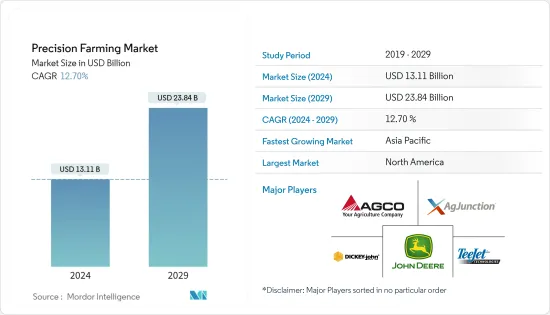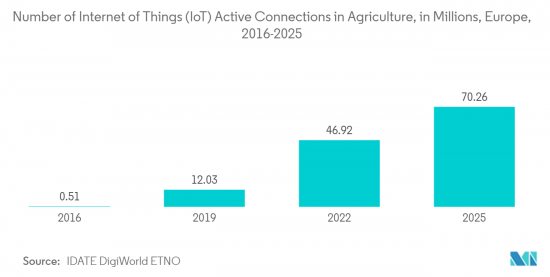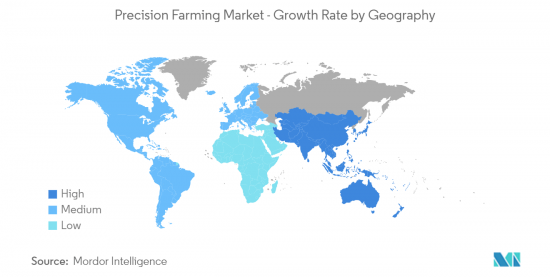 |
市场调查报告书
商品编码
1429232
精密农业:市场占有率分析、产业趋势与统计、成长预测(2024-2029)Precision Farming - Market Share Analysis, Industry Trends & Statistics, Growth Forecasts (2024 - 2029) |
||||||
※ 本网页内容可能与最新版本有所差异。详细情况请与我们联繫。
精密农业市场规模预计2024年为131.1亿美元,预计2029年将达到238.4亿美元,在市场估算和预测期间(2024-2029年)复合年增长率为12.70%。

气候变迁、粮食需求增加、全球农业部门越来越多地采用智慧技术以及政府透过新技术提高农民效率的努力是推动精密农业采用的关键因素。
主要亮点
- 精密农业是一种农业管理概念,其核心是注意到、测量和应对田地内和田间作物的变化。植物生产集中在由财产边界、特定田地的预期平均作物产量以及区域和生态学因素决定的地块上。
- 2030年终,精密农业预计将超越其他进步,成为农业领域最具影响力的趋势。遥感和地面通讯插座透过行动应用程式提供有关设备的即时资讯。可变比率技术(VRT)使农民能够做出更客製化的土地管理决策,使他们能够在不同的田间条件下更有效地使用种子、肥料和农药等投入品。
- 更广泛市场中的大多数供应商都提供导引系统、气候/天气预报和输入散布设备。这家小型供应商主要针对智慧灌溉和田间监测技术,并专注于物联网解决方案。北美是技术的早期采用者,对精密农业中使用的许多创新技术的采用率很高。该地区在农业中大量采用了物联网、巨量资料、无人机和机器人技术。然而,全球趋势也反映在该地区。 i. 由于基础设施和可用服务提供者的不同,各种技术的采用趋势因地区而异。例如,在美国,McFadden 和 Schimmelpfenning 报告称,精密农业公司在地理上较为集中,总部至少位于美国38 个州。许多采用趋势也取决于该地区服务供应商的类型和数量。
- 此外,驱动因素:对限制器、导引系统和 GPS 感测系统等技术的投资增加预计也将有助于研究期间精密农业市场规模的扩大。例如,2022 年 4 月,农业科技公司 EarthScout 将透过提供有关土壤湿度和土地生长限制的即时资料,帮助农民和食品生产者在干旱期间节约用水并减少灌溉和投入。我们已经宣布在我们的可扩展产品系列中添加一个独特的功能创新农产品可帮助您实现这一目标。创新而独特的 EarthScout Soil Cub 是一款经济实惠、紧凑的 4.5"x3"x2"商务用感测器,可安装在田间,监测两个土壤深度的土壤湿度、土壤温度和EC。种植者可以看到整个土壤的水分和养分等级根区域并调整输入。
- 此外,村田製作所于 2022 年 4 月宣布推出一款高精度三合一土壤感测器,用于资料主导的永续农业。透过监测电导率、水分含量和土壤温度,农民可以最大限度地提高蔬菜产量和质量,同时最大限度地减少肥料和水等资源。
- 此外,越来越多的政府措施支持采用现代农业技术和改善基础设施,也有助于该区域市场的高收益。例如,隶属于美国农业部的 NIFA 开展感测器、地理空间和精密技术项目,以提高农民的意识。 NIFA 正在与兰德格兰德大学合作,帮助农民开发强大的感测器、相关软体和仪器,以观察、建模和分析各种复杂的生物材料和过程。此外,2022年5月,加拿大政府宣布投资441,917.5美元,开发果树精密农业综合系统。该投资还旨在获得永续的解决方案,以应对加拿大苹果产业日益严峻的挑战。
- COVID-19 大流行对全球精密农业市场产生了负面影响,导致中国、印度、欧洲、日本和美国的多个工业设施暂时关闭。受此影响,精密农业装备产量大幅下降。冠状病毒大流行后政府强制关闭,对该行业产生了影响,并抑制了消费者对此类高价值资本财的需求。
- 然而,在 COVID-19 之后,遥感和农场管理软体技术的引入可能会导致更广泛的普及。公司已经开始更专注于支援作物健康监测、产量监测、灌溉调度、田间测绘和作物管理即时决策的无线平台。这可能会在预测期内推动所研究的市场需求。
精密农业市场趋势
土壤监测可望占有较大份额
- 有些农民拥有检测土壤湿度和健康状况的具体知识,但这种知识仅限于少数农民。在气候变迁时代,根据土壤湿度和健康做出农业决策变得更加困难。土壤感测器测量重要的土壤特性,并透过可靠的通讯将其转发到显示设备。土壤感测器通常用于可变速率应用,并与 GPS 结合创建根据土壤特性分类的现场地图。土壤感测器对于监测收穫季节作物的生存能力至关重要。
- 感测器在资料分析后产生即时资讯并触发施用量的相应变化。使用基于地图的方法的传统模型被认为更有效率。它们为下一步分析问题和调整可变施用量提供了空间。就工业研究而言,用于土壤监测目的整合的不同类型的感测器包括电磁、光学、机械、声学、电化学等。
- 此外,由于世界各地先进农民越来越多地使用各种土壤监测感测器,预计地面监测系统将在预测期内主导需求。地面监控拥有很大的市场占有率,因为它需要很少的技术知识。智慧感测器技术的改进以及与物联网模组的整合推动了对连网型农业的需求。
- 此外,一种名为 SoilSense 的设备是一种低成本智慧土壤监测系统,它正在兴起,为那些在农业决策中苦苦挣扎的农民提供了潜在的帮助。 Proximal Soilsens Technologies Pvt 开发了 Soilens 产品线。新兴企业得到了科学技术部 (DST) 以及电子和资讯技术部的支持,坐落于孟买的印度理工学院孟买分校 (IITB)。该系统整合了土壤湿度感测器、土壤温度感测器、环境湿度感测器和环境温度感测器。透过智慧型手机应用程序,农民可以根据这些参数推荐最合适的灌溉方法。云端也可以存取此资讯。还有可携式土壤湿度系统。
- 根据美国农业部2022年7月消息,保护创新津贴(CIG)农场保护创新试点计画今年预计将获得2,500万美元的投资。透过 CIG,合作伙伴共同努力改善农业实践,同时解决对我国水质、水量、空气品质、土壤健康和动物栖息地的担忧。 CIG 的农场试验部门与农民合作,促进尖端保护策略的评估和广泛采用。今年的融资重点是气候智慧型农业实践、灌溉用水管理、肥料管理和土壤健康。
- 此外,2023 年 2 月,村田製作所与长期系统整合合作伙伴 Centinum 合作,推出了 GAIA 土壤监测解决方案。此土壤感测器有助于最大限度地提高作物产量,同时减少化肥使用量并最大限度地减少灌溉所需的水量。
- 此外,农业技术进步可能会进一步推动所研究市场的成长。据 ETNO 称,未来几年欧盟 (EU) 农业中的物联网活跃连接数量预计将增加。预计2022年连线数将达到4692万,2025年连线数将达到7026万。物联网设备在农业中的应用包括使用无人机进行监控和种子分发。

亚太地区将经历显着的市场成长
- 据预测,由于政府努力鼓励采用现代精密农业技术,从而最大限度地提高生产力,预计该地区的研究市场(主要是新兴国家)将在预测期内出现强劲增长。 2022 年,印度政府计划推出 Kisan 无人机,用于作物评估、土地记录数位化以及散布农药和营养物质。 IBEF的数据显示,23与前一年同期比较年(2022年4月至7月)印度农产品和加工食品出口额为95.98亿美元,年增30%。
- IBEF 表示,在价值 1 兆美元的基础设施项目和 Pradhan Mantri 等政府倡议的支持下,印度加工食品市场预计将从近期的1,931,288.7 千万印度卢比(2,630 亿美元)增长到2025 年的34,513,525 亿印度卢比倡议 Sampada Yojana。预计将成长至 4,700 亿卢比(4,700 亿美元)。
- 根据联合国粮食及农业组织 (FAO) 的数据,撒哈拉以南非洲和亚洲 80% 以上的粮食消费是由小农种植的。全球食品加工商和消费者对整个产品生命週期课责的需求不断增长,这为小农开拓了新的机会。作物保护解决方案的精准应用正在改变亚洲的农业部门。据德国 Jebagro GmbH 称,其缅甸子公司近一半的农药产品都是用无人机散布的。
- 许多亚洲国家的服务提供者正在转向先进的散布方法,使亚洲农业成为接受调查的市场供应商的主要关注点。该地区的小农户无需投资昂贵的基础设施,就可以更轻鬆地获得智慧拖拉机、无人机、整地服务、卫星图像、农作物散布、灌溉服务以及手持式决策诊断和决策支援。在日本等国家,农民的平均年龄为67岁。因此,在劳动力短缺的情况下,精密农业对于粮食生产和安全至关重要。
- 此外,2022 年 12 月。印度生鲜食品公司 IG International 宣布与 Fyllo 合作,Fyllo 是一家基于 SaaS 的精密农业公司,由人工智慧、机器学习和物联网提供支援。预计这将使公司能够利用人工智慧、机器学习和物联网进行精密农业,生产高品质的水果。作为联盟的一部分,IG International 的企业农场将与土壤分析和灌溉管理设备 Nero 整合。
- 泰国投资委员会透过直接投资和商业配对服务促进Start-Ups计划和企业的发展。大疆创新和极飞科技等领先的无人机公司正在该地区的价值链中推广该技术,以基于先进的服务选项创建新的本地业务。 ListenField 连接卫星、无人机、感测器和农场资料,提供分析和建议,并与日本的许多组织合作。一个值得注意的计划是与日本、印度和泰国的大学合作开发气候智慧型资料库农业。
- 印度农业政策最近认识到智慧农业的好处,重点是到 2022 年使农民收入翻倍。政府还推出了多语言行动应用程式“CHC-Farm Machinery”,农民可以透过当地的CHC租赁和安装农业机械。像 Barton Breeze 这样使用水耕和其他形式的无土耕作的Start-Ups,儘管受到限制,仍继续经营自己的农场。据 DataLabs 称,印度估计有超过 1,090 家农业技术Start-Ups,该行业处于技术革命的先锋,特别是在无人机、物联网设备、人工智慧和卫星影像资料分析方面。

精密农业产业概况
精密农业市场由几家主要企业组成。从市场占有率来看,目前该市场由几家主要企业占据。这些拥有显着市场占有率的领先公司致力于扩大海外基本客群。这些公司利用集体策略倡议来增加市场占有率和盈利。市场表现良好的公司也正在收购致力于精密农业技术的新兴企业,以增强其产品能力。
2022 年 11 月,Elders 与 Precision Agriculture Pty Ltd. 合作,帮助农民提高养分利用率并提高作物永续性。这项新的合作关係使精准农业的专业服务,包括建立土壤管理区、个人化土壤测试和识别关键土壤限制,更容易为埃尔德斯的客户所使用。
2022 年 3 月,投资管理公司 Signature 与 Start Life 合作,最大限度地利用自然资源并加强非洲和公司未来几年将发展的其他地区的粮食安全。这种伙伴关係可以为影响力主导的高科技新兴企业提供一条在农场检验最尖端科技的途径。
其他福利:
- Excel 格式的市场预测 (ME) 表
- 3 个月的分析师支持
目录
第一章简介
- 研究假设和市场定义
- 调查范围
第二章调查方法
第三章执行摘要
第四章市场洞察
- 市场概况
- 产业吸引力-波特五力分析
- 买方议价能力
- 供应商的议价能力
- 新进入者的威胁
- 替代品的威胁
- 竞争公司之间敌对关係的强度
- 评估 COVID-19 对产业的影响
第五章市场动态
- 市场驱动因素
- 使用人工智慧和物联网技术的土壤监测正在推动市场
- 新技术的出现
- 政府措施和新兴企业的崛起
- 市场挑战
- 由于地区意识的差异,实施模式因地区而异。
- 市场机会
- 技术进步正在降低许多先进设备的成本。
- 支援光达的无人机等技术进步、资料分析和该领域云的出现
第六章市场区隔
- 依技术
- 引导系统
- 全球定位系统 (GPS)/全球卫星导航系统 (GNSS)
- 全球资讯系统(GIS)
- 遥感
- 可变利率技术
- 变数肥料
- 变速播种
- 变速农药
- 无人机和无人机
- 其他技术
- 引导系统
- 按成分
- 硬体
- 软体
- 按服务
- 按用途
- 产量监控
- 可变利率申请
- 现场测绘
- 土壤监测
- 作物侦察
- 其他用途
- 按地区
- 北美洲
- 美国
- 加拿大
- 欧洲
- 德国
- 英国
- 法国
- 欧洲其他地区
- 亚太地区
- 中国
- 日本
- 印度
- 澳洲
- 其他亚太地区
- 拉丁美洲
- 中东/非洲
- 北美洲
第七章 竞争形势
- 公司简介
- AGCO Corporation
- Ag Junction Inc
- John Deere
- DICKEY-john Corporation
- TeeJet Technologies
- Raven Industries Inc.
- Lindsay Corporation
- Topcon Precision Agriculture
- Land O'lakes Inc.
- BASF SE
- Yara International ASA
第八章投资分析
第9章市场的未来
The Precision Farming Market size is estimated at USD 13.11 billion in 2024, and is expected to reach USD 23.84 billion by 2029, growing at a CAGR of 12.70% during the forecast period (2024-2029).

Changing climate, growing demand for food, increasing the adoption of smart technologies in the global agriculture sector, and government initiatives to enhance farmers' efficiency through new technologies are some of the major factors driving the adoption of precision farming.
Key Highlights
- Precision farming is an agricultural management concept centered on noticing, measuring, and reacting to crop variability within and between fields. Plant production is focused on land parcels determined by property lines, the anticipated average crop yield of a particular field, and regional and ecological factors.
- By the end of 2030, precision farming is expected to become the most influential trend in agriculture, eclipsing other advancements. Remote sensing and ground communication outlets enable real-time information about equipment through the mobile app. Variable-rate technologies (VRTs) have allowed farmers to make more customized land management decisions, enabling more efficient use of inputs such as seeds, fertilizers, and pesticides under variable in-field conditions.
- Most broad-market vendors offer guidance systems, climate-weather predictions, and input applications equipment. Small vendors mainly target smart irrigation and field monitoring techniques specializing in IoT solutions. North America is the early adopter of technology and has a significant adoption rate of many innovative technologies used in precision farming. The region is a substantial adopter of IoT, big data, drones, and robotics in agriculture. However, the global trend is also reflected in the region, i.e., adoption curves of various technologies vary by region because of infrastructure and available service providers. For instance, within the United States, McFadden and Schimmelpfenning reported that precision agriculture companies are headquartered in at least 38 US states but are geographically concentrated. Many adoption trends also depend on the area's type and number of service providers.
- Moreover, growing investments in technologies such as driverless tractors, guidance systems, and GPS sensing systems are also anticipated to contribute to the precision agriculture market scope growth during the study period. For instance, in April 2022, Agtech firm EarthScout announced a unique addition to its scalable line of innovative agriculture products that assist farmers and food producers during a drought to save water and reduce irrigation and inputs by providing real-time data about soil moisture and growing constraints on their land. The innovative, unique EarthScout Soil Cub is an affordable, miniature 4.5"x3"x2" commercial-grade sensor that's installed in the field to monitor soil moisture, soil temperature, and EC at two soil deeps so growers can see moisture and nutrient grades throughout the root site and adjust inputs.
- Further, in April 2022, Murata introduced a high-accuracy 3-in-1 soil sensor for data-driven sustainable agriculture. By monitoring the electrical conductivity, water content, and soil temperature, the sensor allows farmers to maximize the yield and quality of vegetables while minimizing resources such as fertilizers and water.
- Moreover, Increasing government initiatives that support the adoption of modern agriculture technologies and developed infrastructure have contributed to the high revenue of the regional market. For instance, the NIFA, a part of the U.S. Department of Agriculture, conducts sensor, geospatial, and precision technology programs to build awareness among farmers. In collaboration with Land-Grand universities, NIFA helps farmers generate robust sensors, associated software, and instrumentation for observing, modeling, and analyzing a broad range of complex biological materials and processes. Furthermore, in May 2022, the Government of Canada announced an investment of USD 4,41,917.5 to develop an integrated system for precision fruit tree farming. The investment also aimed to acquire sustainable solutions to tackle the uprising challenges in Canada's apple industry.
- The COVID-19 pandemic negatively impacted the global market for precision farming, resulting in the temporary closure of multiple industrial facilities in China, India, Europe, Japan, and the United States. As a result, the manufacturing of precision farming equipment significantly decreased. Government-enforced shutdowns following the coronavirus pandemic impacted the industry and slowed consumer demand for such expensive capital goods.
- However, more significant adoption could result from deploying remote sensing and farm management software technologies after COVID-19. Businesses have already started concentrating more on wireless platforms to support real-time decision-making for crop health monitoring, yield monitoring, irrigation scheduling, field mapping, and harvesting management. This may propel the studied market demand in the forecasted period.
Precision Farming Market Trends
Soil Monitoring is Expected to Hold Significant Share
- While some farmers have specific knowledge of detecting soil moisture and health, such knowledge is confined to only a few. Making farming decisions based on soil moisture and fitness has become even more difficult in the age of climate change. Soil sensors measure essential soil properties and relay them to a display device through reliable communication. Soil sensors are generally used in conjunction with variable rate applications or GPS to generate field maps, categorized according to the properties of the soil. Soil sensors are crucial to monitor the feasibility of the growth of the crops during the harvesting period.
- Sensors generate real-time information after the data analysis and cause the corresponding changes in the application rate. Conventional models of the utilization of a map-based approach are considered to be more productive. They allow space for problem analysis and adjusting the variable rate application in the following steps. The various type of sensors being integrated for soil monitoring purposes includes electromagnetic, optical, mechanical, acoustic, and electrochemical, as far as industrial research has reached.
- In addition, ground-based monitoring systems are anticipated to dominate the demand during the forecast period due to the increased use of various soil monitoring sensors among forward-thinking farmers worldwide. Ground-based monitoring has a sizable market share because it requires little technical knowledge. The demand for connected farming results from improvements in intelligent sensor technology and their integration with IoT modules.
- Additionally, a device called Soilsens, a low-cost smart soil monitoring system, has emerged as a potential aid to farmers struggling to make a farming decision. Proximal Soilsens Technologies Pvt created the Soilsens product line. Ltd, a startup supported by the Department of Science and Technology (DST) and the Ministry of Electronics and Information Technology and housed in the Indian Institute of Technology Bombay (IITB), Mumbai. A soil moisture sensor, a soil temperature sensor, an ambient humidity sensor, and an ambient temperature sensor are all built into the system. Farmers are given recommendations for the best irrigation practices based on these parameters through a smartphone app. The cloud also has access to this information. A portable soil moisture system is also available.
- In July 2022, the Conservation Innovation Grants (CIG) On-Farm Conservation Innovation Trials program was expected to receive a USD25 million investment this year, according to USDA. Through CIG, partners collaborate to improve agricultural practices while addressing concerns with our country's water quality, water quantity, air quality, soil health, and animal habitat. The CIG's On-Farm Trials component promotes the evaluation and broad adoption of cutting-edge conservation strategies in collaboration with farmers. This year's financing priorities are climate-smart agriculture practices, irrigation water management, fertilizer management, and soil health.
- Additionally, in February 2023, Murata, in collaboration with longstanding systems integration partner Sentinum, announced the GAIA soil monitoring solution, which, according to the company, could have a crucial role to play in smart agriculture. These soil sensors help maximize crop yields while decreasing fertilizer use and minimizing the amount of water needed for irrigation.
- Furthermore, technological advancement in farming may further propel the studied market growth. According to ETNO, the number of IoT active connections in agriculture was expected to increase in the European Union through the years. It was recorded at 46.92 million connections in 2022 and is expected to reach 70.26 million by 2025. Some uses for IoT devices in agriculture would be drone usage for surveillance or distributing seeds.

Asia-Pacific to Experience Significant Market Growth
- The region is anticipated to witness significant growth over the forecasted period in the studied market, primarily due to government initiatives in developing countries to encourage the implementation of modern precision farming technologies, thereby maximizing productivity. In 2022, the Government of India planned to launch Kisan Drones for crop assessment, digitization of land records, and spraying insecticides and nutrients. According to IBEF, India's agricultural and processed food products exports stood at USD 9,598 million in FY23 (April-July 2022), up by 30% year on year.
- According to IBEF, the processed food market in India is expected to grow to INR 3,451,352.5 crore (USD 470 billion) by 2025, from INR 1,931,288.7 crore (USD 263 billion) recently on the back of government initiatives such as planned infrastructure worth USD 1 trillion and Pradhan Mantri Kisan Sampada Yojana.
- According to the UN's Food and Agriculture Organization (FAO), more than 80% of the food consumed in sub-Saharan Africa and Asia is grown by smallholder farmers. Growing global demand from food processors and consumers for accountability for the entire product lifecycle is developing new access opportunities for smallholder farmers. Precision application of crop protection solutions is changing the agriculture sector in Asia. According to the German-based company Jebagro GmbH, its Myanmar subsidiary applies almost half of its pesticide products with UAVs.
- Service providers in many Asian countries are leapfrogging to advance application methods, making Asian agriculture the prime focus for the studied market vendors. Smart tractors, UAVs, ground leveling services, satellite imaging, pesticide application, irrigation services, and handheld decision diagnostics and decision support are becoming more accessible for smallholder farmers in the region without investment in expensive infrastructure. In countries like Japan, the average farmer's average age is 67; therefore, with labor shortages, precision farming is significant for food production and security.
- Further, in December 2022. Indian fresh produce company IG International announced a collaboration with Fyllo, an AI, ML, IoT-driven, SaaS-based precision agriculture company. This was expected to help companies use precision farming with AI, ML, and IoT to produce high-quality fruits. As a part of Alliance, IG International's corporate farms would be integrated with 'Nero,' a soil analysis and irrigation management device.
- The Thailand Board of Investment promotes startup projects and companies through direct investment and business matchmaking services. Major drone companies, like DJI and XAG, are pushing their technology in the region through the value chain to create new local businesses based on advanced service options. ListenField, which connects satellites, drones, sensors, and on-farm data, delivers analysis and recommendations and collaborates with numerous organizations in Japan. One notable project involves working with universities in Japan, India, and Thailand on data-based farming in the face of climate change.
- India's agricultural policies have recently acknowledged the advantage of smart farming and focused on doubling farmers' income by 2022. The government also introduced the multilingual mobile app 'CHC-Farm Machinery,' enabling farmers to rent and implement farm machinery through a CHC in their area. Startups, such as Barton Breeze, have been doing hydroponic and other soil-less farming, and their farms continue to operate even in lockdown. According to DataLabs, India is estimated to have more than 1090 agritech startups, and this sector has been spearheading a revolution in technology, especially in drones, IoT devices, and data analytics to AI and satellite imagery.

Precision Farming Industry Overview
The precision farming market consists of several major players. In terms of market share, few of the significant players currently dominate the market. These major players, with a prominent market share, focus on extending their customer base across foreign countries. These firms leverage collective strategic initiatives to increase their market share and profitability. The companies performing in the market are also acquiring start-ups working on precision farming technologies to strengthen their product capabilities.
In November 2022, Elders and Precision Agriculture Pty Ltd. partnered to help farmers improve their nutrient utilization and increase the sustainability of their crops. The new arrangement made Precision Agriculture's specialized services, such as establishing soil management zones, individualized soil testing, and identifying significant soil restrictions, more easily accessible to Elders clients.
In March 2022, to maximize natural resources and enhance food security in Africa and other regions where the company would grow in the upcoming years, investment management firm Signature partnered with StartLife. The partnership could offer a path to on-farm validation of cutting-edge technologies for impact-driven tech startups.
Additional Benefits:
- The market estimate (ME) sheet in Excel format
- 3 months of analyst support
TABLE OF CONTENTS
1 INTRODUCTION
- 1.1 Study Assumptions and Market Definition
- 1.2 Scope of the Study
2 RESEARCH METHODOLOGY
3 EXECUTIVE SUMMARY
4 MARKET INSIGHTS
- 4.1 Market Overview
- 4.2 Industry Attractiveness- Porter's Five Forces Analysis
- 4.2.1 Bargaining Power of Buyers
- 4.2.2 Bargaining Power of Suppliers
- 4.2.3 Threat of New Entrants
- 4.2.4 Threat of Substitute Products
- 4.2.5 Intensity of Competitive Rivalry
- 4.3 Assessment Of COVID-19 Impact On The Industry
5 MARKET DYNAMICS
- 5.1 Market Drivers
- 5.1.1 Soil Monitoring using AI and IOT technologies to drive the market
- 5.1.2 Emergence of New Technologies
- 5.1.3 Government Initiative and Increasing Number of Startups
- 5.2 Market Challenges
- 5.2.1 Difference in Awareness in Different Regions is also Resulting in Varying Adoption Patterns in These Regions
- 5.3 Market Opportunities
- 5.3.1 Technological Advancement is Reducing the Cost of Many Advance Equipment
- 5.3.2 Advancement in Technologies, like LIDAR-enabled Drones, and Emergence of Data Analytics and Cloud in the Sector
6 MARKET SEGMENTATION
- 6.1 By Technology
- 6.1.1 Guidance System
- 6.1.1.1 Global Positioning System (GPS)/ Global Satellite Navigation System (GNSS)
- 6.1.1.2 Global Information System (GIS)
- 6.1.2 Remote Sensing
- 6.1.3 Variable-rate Technology
- 6.1.3.1 Variable Rate Fertilizer
- 6.1.3.2 Variable Rate Seeding
- 6.1.3.3 Variable Rate Pesticide
- 6.1.4 Drones and UAVs
- 6.1.5 Other Technologies
- 6.1.1 Guidance System
- 6.2 By Component
- 6.2.1 Hardware
- 6.2.2 Software
- 6.2.3 Services
- 6.3 By Application
- 6.3.1 Yield Monitoring
- 6.3.2 Variable Rate Application
- 6.3.3 Field Mapping
- 6.3.4 Soil Monitoring
- 6.3.5 Crop Scouting
- 6.3.6 Other Applications
- 6.4 By Geography
- 6.4.1 North America
- 6.4.1.1 United States
- 6.4.1.2 Canada
- 6.4.2 Europe
- 6.4.2.1 Germany
- 6.4.2.2 United Kingdom
- 6.4.2.3 France
- 6.4.2.4 Rest of Europe
- 6.4.3 Asia-Pacific
- 6.4.3.1 China
- 6.4.3.2 Japan
- 6.4.3.3 India
- 6.4.3.4 Australia
- 6.4.3.5 Rest of the Asia-Pacific
- 6.4.4 Latin America
- 6.4.5 Middle East & Africa
- 6.4.1 North America
7 COMPETITIVE LANDSCAPE
- 7.1 Company Profiles
- 7.1.1 AGCO Corporation
- 7.1.2 Ag Junction Inc
- 7.1.3 John Deere
- 7.1.4 DICKEY-john Corporation
- 7.1.5 TeeJet Technologies
- 7.1.6 Raven Industries Inc.
- 7.1.7 Lindsay Corporation
- 7.1.8 Topcon Precision Agriculture
- 7.1.9 Land O'lakes Inc.
- 7.1.10 BASF SE
- 7.1.11 Yara International ASA













